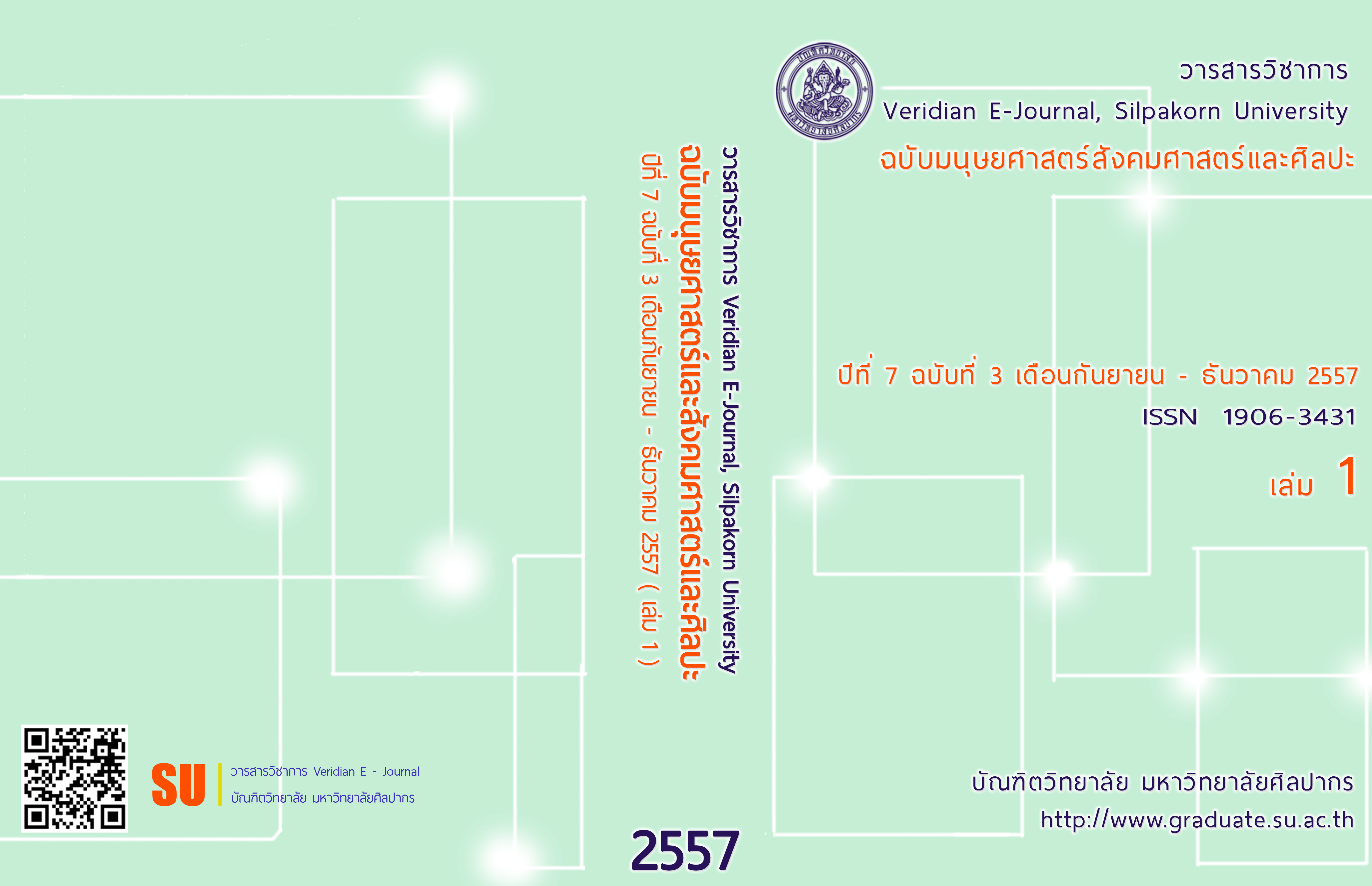แนวความคิดสัจนิยมกับการเปลี่ยนแปลงในงานปูนปั้นสกุลช่างเพชรบุรี/Realism Movement in Stucco of Phetchaburi School
Main Article Content
Abstract
บทคัดย่อ (การสอดแทรกเนื้อหาร่วมสมัยหรือรูปบุคคลที่มีชื่อเสียง ได้แก่ นักการเมือง ดารา และนักดนตรี และรูปแบบการปั้นลวดลายประดับปูนปั้นให้มีองค์ประกอบบางส่วนนูนสูงหรือลอยตัวพ้นจากระนาบของหน้าบันอาคารถือเป็นแนวทางการแสดงออกที่รับทราบกันโดยทั่วไปว่าเป็นเอกลักษณ์อย่างหนึ่งในงานงานปูนปั้นสกุลช่างเพชรบุรี จากการศึกษางานปูนปั้นสกุลช่างเพชรบุรียุคปัจจุบันพบว่าการแสดงเนื้อหาร่วมสมัยเป็นความนิยมปรากฏเฉพาะในเครือข่ายช่างทองร่วงเอมโอษฐ์เท่านั้น ตรงข้ามกับรูปแบบการปั้นลวดลายให้มีองค์ประกอบบางส่วนนูนสูงหรือลอยตัวจะเป็นแบบอย่างนิยมโดยทั่วไปในกลุ่มช่างปูนปั้นสกุลช่างเพชรบุรี ข้อสังเกตดังกล่าวนำไปสู่ประเด็นคำถามในบทความฉบับนี้ว่ากระแสงานช่างในเมืองเพชรบุรียุคก่อนหน้า โดยเฉพาะงานศิลปะสัจนิยมส่งผลต่อพัฒนาการดังกล่าวในงานปูนปั้นอย่างไร และเป็นแนวทางที่เคยปรากฏมาก่อนในงานปูนปั้นเมืองเพชรบุรีหรือไม่ ผลจากการศึกษาพบว่า 1. กระแสงานศิลปะสัจนิยม หรือการสร้างงานศิลปะที่แสดงออกถึงเนื้อหา หรือการแสดงภาพแบบสมจริงปรากฏมาขึ้นและมีพัฒนาการในงานจิตรกรรมเมืองเพชรบุรี ตั้งแต่ราวสมัยรัตนโกสินทร์รัชกาลที่ 5 และให้อิทธิพลต่องานประติมากรรม ราว พ.ศ. 2460เป็นต้นมาถึงปัจจุบัน 2. การสอดแทรกเนื้อหาแนวใหม่ได้แก่ ผู้คน วัตถุ อาคาร และสถานที่ร่วมสมัย กิจวัตรชาวบ้าน และปริศนาธรรมปรากฏเด่นชัดในงานจิตรกรรมสกุลช่างเพชรบุรี ราว พ.ศ. 2460-2500 และเป็นพื้นฐานสู่การแสดงเนื้อหาร่วมสมัยเชิงปัจเจกบุคคลในงานของช่างทองร่วงเอมโอษฐ์ ก่อนจะถ่ายทอดความนิยมดังกล่าวสู่ช่างในเครือข่ายที่เคยฝึกและทำงานร่วมกับช่างทองร่วง เอมโอษฐ์ 3. การปั้นลวดลายให้มีองค์ประกอบบางส่วนนูนสูงหรือลอยตัวจากระนาบพื้นผนังอาคารเป็นแบบอย่างที่ปรากฏมาก่อนในงานปูนปั้นและงานสลักไม้ประดับหน้าบันอาคาร ระหว่าง พ.ศ. 2460-2510ซึ่งพบว่ามีความสัมพันธ์กับแนวทางการสร้างงานศิลปะแบบสัจนิยม และกลายเป็นแบบแผนสืบมาในงานปูนปั้นสกุลช่างเพชรบุรียุคปัจจุบัน)Abstract (Phetchaburi School has aunique style of making stucco. The style includes representing contemporaryconcepts, famous celebrity namely politicians, film stars and musicians instuccos. Most recognizably, patternsand designs of stucco of this school allow some parts to have a high relief effect or even sculpturaleffects. The high relief and a sculpture that look as if they emerge fromsurface of pediment have been claimed as a very unique style of PhetchaburiSchool. The desk research sets offwith a remark that there are two dominant styles of Phetchaburi School. ThePhetchaburi stucco that represents contemporary stories and people is a popularpractice among Thongroung Em-Oat and his networks. The other is the uniquestyle of pattern and design that create high relief and sculpture on thesurface. This style is generally adopted by both Thongroung and other smallergroups of artisans. This remark leads to a question of this research study;whether earlier style of Phetchaburi School, particularly a realism concept,has any impacts on the development of Phetchaburi School and if there has beensuch styles in early Phetchaburi School. This research paper aims toinvestigate the pattern of arts in early Phetchaburi School and its influenceupon the present Phetchaburi School. The result of this researchstudy discovers 3 significant issues as following; First, a creation of art that represent storiesor a realism concept has already been embedded in the early Phetchaburi Schoolsince the reign of King Rama V of Rattanakosin era. The realism movement hasinfluence upon Phechaburi sculptures from 2460 BE to the present time, Second, a representation ofstories namely people, object, building, contemporary places, local people’sway of life and riddles was a unique style of Phetchaburi art particularly invisual arts during 2460-2500 BE. This is a platform for the artisan ThongruongEm-Oat and his apprentices to express their individual comments on contemporaryevents and people in the stuccos and, Lastly, a making of high relief and sculptureemerging from the surface of a wall which is the most recognizable practiceof Phetchabui School’s stuccos hadalready been found in stuccos and woodcarving on the pediment of building in Phetchaburi during 2460-2510 BE. Thetraditional practice that has been most conformed by the present PhetchaburiSchool develops from the realism art concept.)
Article Details
Section
บทความ : มนุษยศาสตร์ สังคมศาสตร์ และศิลปะ
